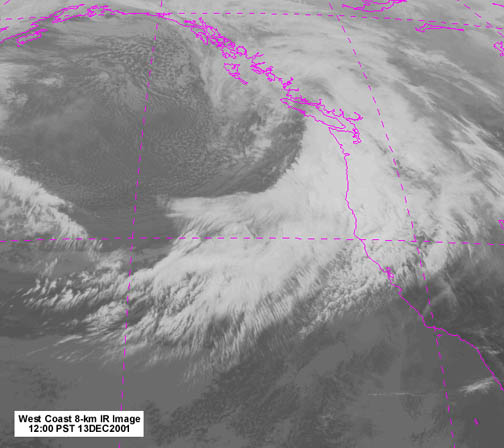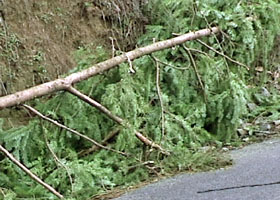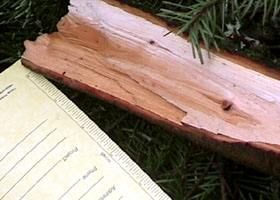The storm of December 13, 2001 was one of the strongest
of the 2001-02 season, producing heavy rain and strong winds across a wide
area in the Pacific Northwest, though, overall, a couple of the storms from
November 2001 probably had the edge in wind speeds. However, when compared
the earlier storms of the season, the December 13th storm had an added feature--as
the cold front dove across the Willamette Valley, undercutting a warm, moist
sector of air that had been pulled in out of the south by the cyclonic flow,
a narrow, but intense, squall line built up and tore through the SE Portland
Metro area. The tempest hit my neighborhood dead on, producing the highest
winds and heaviest short-duration rains of the storm season. My journal
entries, and some images, will show the rest, but before going into the
details, a few things should be noted at first.
The squall was spawned by a developing 980 mb cyclone that moved in out
of the west. The cyclone's center crossed the Northern Olympic Peninsula
and carried a very moist front inland. Heavy rain was reported at most interior
stations at various times during the storm. Gusty south winds developed
along the front, and in some valley locations approached 50 mph. This storm
followed a track that could have resulted in even higher winds than those
that were recorded. Interior gradients peaked at about +6.2 mb (+0.18")
for EUG-PDX at 19:00 on the 13th and +10.6 mb (+0.31") for PDX-SEA
at 01:00 on the 14th. On the coast, the peak ACV-AST gradient reached +23.9
mb (+0.69") at 13:00 on the 13th and the max OTH-UIL was +21.4 mb (+0.63")
also at 13:00. These are strong gradients, but not quite at the level typically
observed during big windstorms. Another 2 to 4 mb higher for the interior,
and 50 to 60 mph gusts probably would have been more common.
The Aurora, OR, (UAO) airport was the closest official observation station
to my location at the time of the storm (I have since moved), which is why
it appears fairly often in the account below. Compared to my former site,
UAO is more centrally located in the Willamette Valley. My location was
closer to the foothills among rougher topography, which appeared to make
for more turbulent (and weaker) winds in the region around my home.
To get an idea of the magnitude of the precipitation during the actual
squall, pay close attention to the entry at 15:07 HRS. The rain rate reported
at that time, falling in prefrontal warm air advection conditions, is fairly
heavy for low-elevation Pacific Northwest interior locations (0.15-0.30"/hr
is going at a really good clip down in the valley). The rainfall rate during
the squall was much, much higher. |






